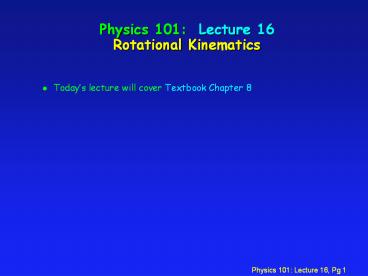Physics 101: Lecture 16 Rotational Kinematics PowerPoint PPT Presentation
1 / 9
Title: Physics 101: Lecture 16 Rotational Kinematics
1
Physics 101 Lecture 16Rotational Kinematics
- Todays lecture will cover Textbook Chapter 8
2
Rotational Kinematics
- The motion of a rigid body about a fixed axis is
described by using the same concepts as for
linear motion (see CJ Chapter 2) - Displacement (Dq), Velocity (w),
Acceleration (a) - Angular Displacement
- Identify the axis of rotation and choose a line
- perpendicular to this axis. Observe the motion of
a point - on this line. How can one define the change of
position of - this point during rotation about an axis ?
- Answer
- Change of angle the line makes with a reference
line Dq
3
Angular Displacement
- Follow point P on line perpendicular to the
rotation axis
tt0
ttf
q00
qf
P
reference line
-qf
counter clockwise clockwise
Angular displacement Dq qf - q0 qf
Dq -qf SI unit radian
(rad) 1 rad 360 degrees/(2 p)
Dq (in rad) arc length /
radius s/r
4
Angular Velocity and Acceleration
- With the concept of displacement in place we can
now - define angular velocity and acceleration to
describe the - motion of a rigid body rotating about an axis
- Average angular velocity angular
displacement/elapsed time - wave Dq / Dt
(qf-q0)/(t-t0) - Average angular acceleration change in velocity
/elapsed time - aave Dw /Dt
(wf-w0)/(t-t0)
5
See text chapter 8
Rotational Kinematics(with comparison to 1-D
linear kinematics)
Angular Linear
v2 v02 2 a Dx
See Table 8.1
6
Angular and Tangential Variables
- A point on a line perpendicular to the rotation
axis at distance R from the rotational axis moves
with a tangential speed (t00s,q00) - vT s/t q R/t w R (q in
rad and w in rad/s) - and an average tangential acceleration
- aT (vT0 vTf)/t R
(w0-wf)/t a R - How does this relate to the case of uniform
circular motion we - discussed before ?
- Uniform motion constant tangential
speed and aT 0 - The change of direction of vT, however, results
into a centripetal - acceleration ac vT2/R w2 R
(constant) - Nonuniform motion increasing/decreasing
tangential speed - Magnitude of the total acceleration is then given
by - a (aT2
ac2)1/2
7
Conceptual Question
- You and a friend are playing on the
merry-go-round. You stand at the outer edge of
the merry-go-round and your friend stands halfway
between the outer edge and the center. Assume the
rotation rate of the merry-go-round is constant. - Who has the greatest angular velocity?
- 1. You do 2. Your friend does 3. Same
you
Since the angular displacement is the same in
both cases.
8
Conceptual Question
you
- Who has the greatest tangential velocity?
- 1. You do 2. Your friend does 3. Same
This is like the example of the "crack-the-whip."
The person farthest from the pivot has the
hardest job. The skater has to cover more
distance than anyone else. To accomplish this,
the skater must skate faster to keep the line
straight. vT w R (w is the
same but R is larger)
9
Concept Question
you
- Who has the greatest centripetal acceleration?
- 1. You do 2. Your friend does 3. Same
Things toward the outer edge want to "fly off"
more than things toward the middle. Force is
greater on you because you want to fly off more.
Centripetal acceleration is ac R w2 and you
have the largest radius.

